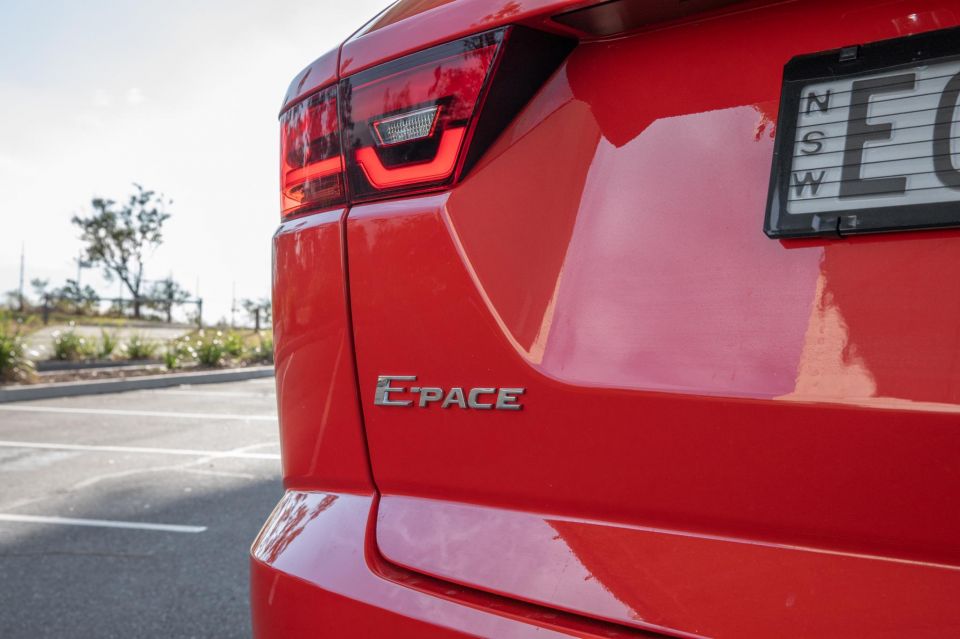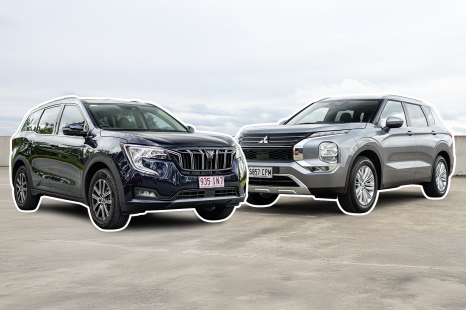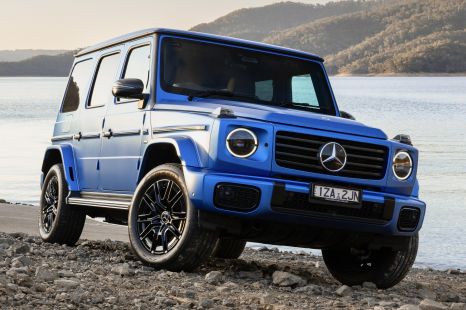

Josh Nevett
3 Days Ago
The new entry model in the Jaguar E-Pace range also happens to be the only variant you should buy, but does it stack up against the Germans and Swedes?



Publisher
New from
$58,730
excl. on-roads

Publisher
New from
$58,730
excl. on-roads


Publisher
New from
$58,730
excl. on-roads

Publisher
New from
$58,730
excl. on-roads
Quickly see how this car stacks up against its competition. Select any benchmark to see more details.
Take advantage of Australia's BIGGEST new car website to find a great deal on a Jaguar E-Pace.
The Jaguar E-Pace is very much an unknown SUV in Australia. With around 1000 sold last year, Jaguar’s smallest SUV has yet to find its feet against its German and Swedish rivals.
But with the introduction of a special Chequered Flag edition – which packages most of the options you want or need at an entry price below the rest of the range – that could soon start to change, as buyers find a value equation that makes sense.

Jaguar’s foray into SUVs started with the larger F-Pace back in 2016, which sat somewhere in size between a Range Rover Sport and an Evoque.
Unlike the F-Pace, which is built on an aluminium lightweight chassis focused on fighting Porsche, the E-Pace is designed as a city-focused small SUV appealing to a wider audience.
It’s a rival for the Audi Q2 and Q3, BMW X1 and X2, the Volvo XC40, and the soon-to-be-replaced Mercedes-Benz GLA.
The Jaguar E-Pace itself is not actually produced by Jaguar in the UK, but made by a company called Magna Steyr in Graz, Austria and is built on the foundations of the previous Range Rover Evoque and Discovery Sport platform.

The facility that builds the Jaguar E-Pace also builds the all-electric I-Pace SUV, Mercedes-Benz G-Wagen, BMW 5 Series, and the BMW Z4 and Toyota Supra twins.
It may be a British car at heart, but it carries with it the precision of German/Austrian build quality.
It is a good looking thing from the outside, especially given how well it manages to blend the best Jaguar design DNA into a modern small SUV, which is no easy task.
It’s also the last model Ian Callum penned for Jaguar. It carries plenty of design elements from its bigger brother, as well as the sporty F-Type.

The E-Pace perhaps doesn’t have the same aggressive styling as the F, but we feel it hits its target market of a high-end suburban luxury high rider rather well, specially in the Photon Red colour on test here.
But the real question about the E-Pace is not about its heritage or its reason to exist, but whether the new super-competitively priced Chequered Flag is reason enough to buy one.
There was a time not long ago Jaguar offered around 35 variants of the E-Pace, with prices starting under $50,000 for a base diesel.
Jaguar as a brand went through a bit of adjustment and, given the complexity of the range, the model line-up was culled significantly. The Chequered Flag edition has now become the entry into the range, which now consists of only four variants.


Even so, despite culling more than 30 variants and engine configurations, Jaguar’s position with the E-Pace Chequered Flag edition is both fantastic and a little odd, because it makes the rest of the reduced range seem unnecessary.
Priced from $65,990 drive-away, the Jaguar E-Pace chequered flag edition is the only E-Pace variant you should be buying.
The closest model in the range is the R-Dynamic ($69,892 before on-roads) which packs fewer standard features. Then there’s the D180 ($75,124 before on-roads) diesel, which you really don’t need in a small SUV unless you do a lot of highway driving.
That leaves the top-spec and rather pricey HSE variant ($83,522 before on-roads) which is nice, but not worth $17,500 more.

Just as a side note, as we love to complain about prices in Australia, the E-Pace Chequered flag edition in its home market of Britain is priced from £40,000, which is about $75,000 on today’s exchange rate.
The Brits pay $9000 more than we do for their own car… and Jaguar Australia has to pay for shipping, so you can be assured that Jaguar is keen to sell some E-Paces in our market.
Historically, Chequered Flag editions have provided a heap of popular features that are otherwise expensive options, and packaged them all into a neat model variant that will have maximum appeal at the lowest price – which is exactly what Jaguar has managed to do in the case of the E-Pace Chequered Flag.


The list of new features is vast, but the main ones are Chequered Flag exterior badging that really compliments the 19-inch Satin Dark Grey wheels.
We like the overall black pack feel of the car, enhanced by R-Dynamic body-coloured bumpers, twin tailpipes, and LED headlamps. As you would expect in a car this price, a powered tailgate and keyless entry are also standard. The red colour here is unique to the Chequered Flag edition.
Open the doors and you’ll see Chequered Flag tread plates that give an extra sensation this is not a regular E-Pace.
It also sets the tone for the Ebony grained leather interior with red stitching for all seats. Speaking of which, the otherwise optional 10-way heated front seats are standard, which is nice, but the highlight of the package is the standard panoramic roof, which you don’t even get in the top-spec HSE ($2160).
We liked the high-resolution 12.3-inch infotainment system that now supports Apple CarPlay (not wirelessly, which is annoying) as well as an R-Dynamic branded steering wheel, black gearshift paddles, and an Ebony Morzine headliner.
The Jaguar E-Pace was tested in 2018, and it scored the maximum five-star safety rating. It misses out on high-speed autonomous emergency braking and pedestrian detection, which would make it unlikely to get a five-star safety rating if tested under the 2020 regulations.
Nonetheless, it scored a maximum of eight of eight points for side impact and 5.33 out of 8 for the frontal offset test.

The E-Pace’s interior may appear a little bland at first, but spend a bit of time with it and its simplicity makes a lot of sense.
It’s not striking or necessarily super-premium, and it’s not like a modern Mercedes-Benz technology showcase, but it’s also not cheap or full of scratchy hard plastics.
There’s not a whole lot of room in the cabin, but Jaguar’s interior designers have managed to keep the design both basic and sophisticated, and befitting of the brand.
The 12.3-inch digital instrument display is very crisp, as is the 10-inch Touch Pro infotainment screen. The latter is much faster than previous Jaguar systems and functional enough to suit the younger audience of the E-Pace, but it’s not on par with what Mercedes-Benz and BMW offer in the GLA and X1 respectively.


In saying that, it does have Apple CarPlay and Android Auto so while the default Jaguar Land Rover system is a bit clumsy and at times counter-intuitive, the ability to simply mirror your phone’s display on the big screen takes a lot of those problems away.
It ticks a fair few boxes for standard features for those sitting in the back, such as rear air vents, front and rear USB ports, and a reasonable amount of head- and legroom for all passengers, though you would be hard-pressed fitting three adults in the back as it’s simply not wide enough.
The E-Pace has a reasonable 484 litres of boot capacity behind the rear seats when in standard position and can grow to as much as 1234 litres when they are folded away (they don’t go fully flat).
Unlike European versions, the E-Pace models delivered to Australia all come standard with a space-saver offered as an option in Europe. If for whatever reason you want to remove that, it will increase boot capacity to 577 litres.
All current Jaguar E-Pace models (except the diesel-powered D180) are powered by the same 2.0-litre turbocharged four-cylinder petrol engine that delivers a healthy 183kW of power and 365Nm of torque.

A nine-speed automatic transmission is in charge of pushing power to all four-wheels and does so very smoothly.
Jaguar claims a fuel economy of 7.7L/100km of premium fuel, we managed to get it to around 9.5L/100km but with a heavy foot.
There’s no denying that the E-Pace is a heavy car. Tipping the scales at around 1830kg (kerb weight), it’s actually heavier than the larger F-Pace, thanks in large to its steel rather than aluminium underpinnings.
Nonetheless, given what the car is built for, the E-Pace we had on test and in this configuration drove smoothly and never felt lacking power or torque.

The 183kW of power from the turbocharged engine is delivered nicely and the 365Nm of torque is more than enough to give you that little shove in the back as you plant the right pedal.
So it should, given it can do 100km/h sprint in just 7.1 seconds. On the go the E-Pace never feels underwhelming or inadequate, even when overtaking on a country highway.
The handling can feel a bit sluggish compared to some of its German rivals, but you won’t pick it unless you’re pushing the little SUV hard. It’s a competent driving package overall and you won’t be left wanting.

We drove our E-Pace all the way from Brisbane to Warwick and then out to Queen Mary Falls with our two young boys and it did a superb job of keeping everyone happy, relaxed, and comfortable.
The optional adaptive cruise control system worked a treat and allowed a relaxing journey through long country roads, and when the time came to overtake trucks or other slow-moving vehicles the E-Pace never missed a beat, even with a full house and luggage.
The new Audi Q3 and the ever-popular Volvo XC40 provide a more complete driving experience for those who really enjoy spirited driving (both weigh around 150kg less), but we would hazard a guess and say the majority of driver’s would not be able to tell the trio apart.

Jaguar is currently offering five-year /unlimited-kilometre factory warranty on the E-Pace, which brings it in line with what you can get from Mercedes-Benz, and goes above the standard offer from Audi and BMW.
Petrol-powered E-Pace models have a requirement based servicing schedule. The service indicator light in the information display will advise when there is less than 3400kms before the vehicle’s next service is due.
The distance countdown is automatically adjusted to allow for driving style and conditions, to accurately gauge when the next service becomes necessary.
However, what you should do is simply buy the five-year, 102,000km service plan for $1950 and you’re pretty much set.

The Chequered Flag is undoubtedly the best value for money E-Pace on sale today, and is priced competitively against an equivalent-spec Volvo XC40.
It’s a solid offering that delivers a classy and well-equipped overall package. You can definitely find yourself in an Audi Q3, Mercedes-Benz GLA or Lexus UX for less money – but that doesn’t account for the individuality on offer in the E-Pace.
Perhaps the only caveat we leave you with is that if the E-Pace doesn’t fit the bill, have a look at the larger F-Pace.
For about $15-20,000 more, you get a whole lot more car with aggressive looks and a better dynamic feel. Plus, it’s always nice to have a bit more room
Take advantage of Australia's BIGGEST new car website to find a great deal on a Jaguar E-Pace.
Alborz is the founder of CarAdvice (sold to Nine and now Drive) and co-founder of CarExpert. He is an honourary adjunct professor & entrepreneur in residence at the University of QLD. He loves naturally-aspirated V8s, V10s and V12s and is in denial about the impending death of the internal combustion engine. The best way to reach him is via Instagram.


Josh Nevett
3 Days Ago


William Stopford
3 Days Ago


James Wong
1 Day Ago


Andrew Maclean
20 Hours Ago


Max Davies
12 Hours Ago


Derek Fung
11 Hours Ago